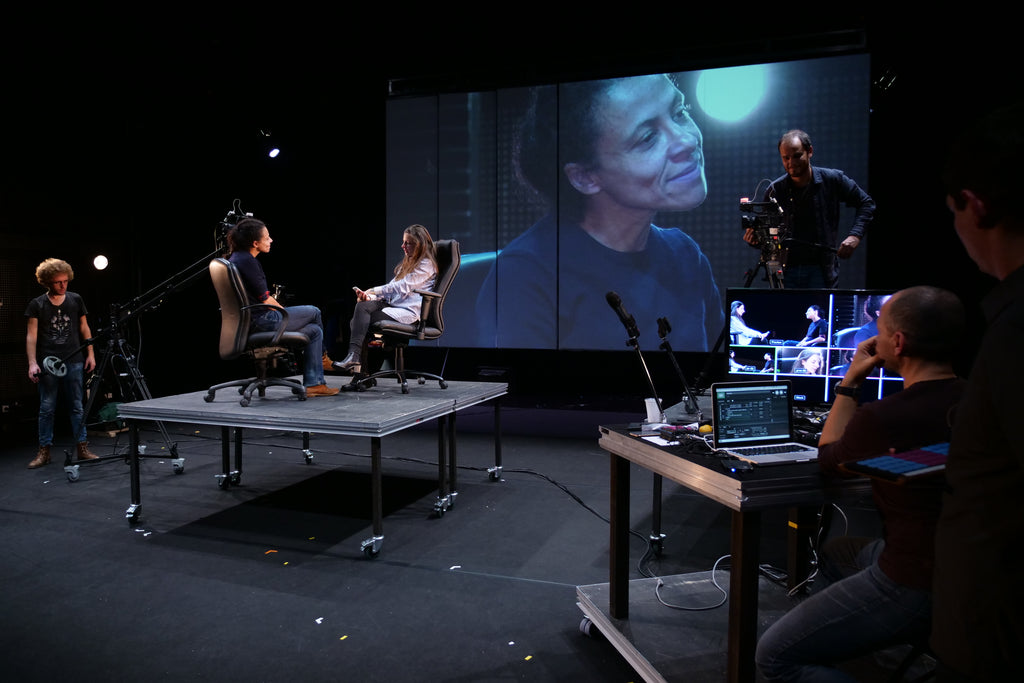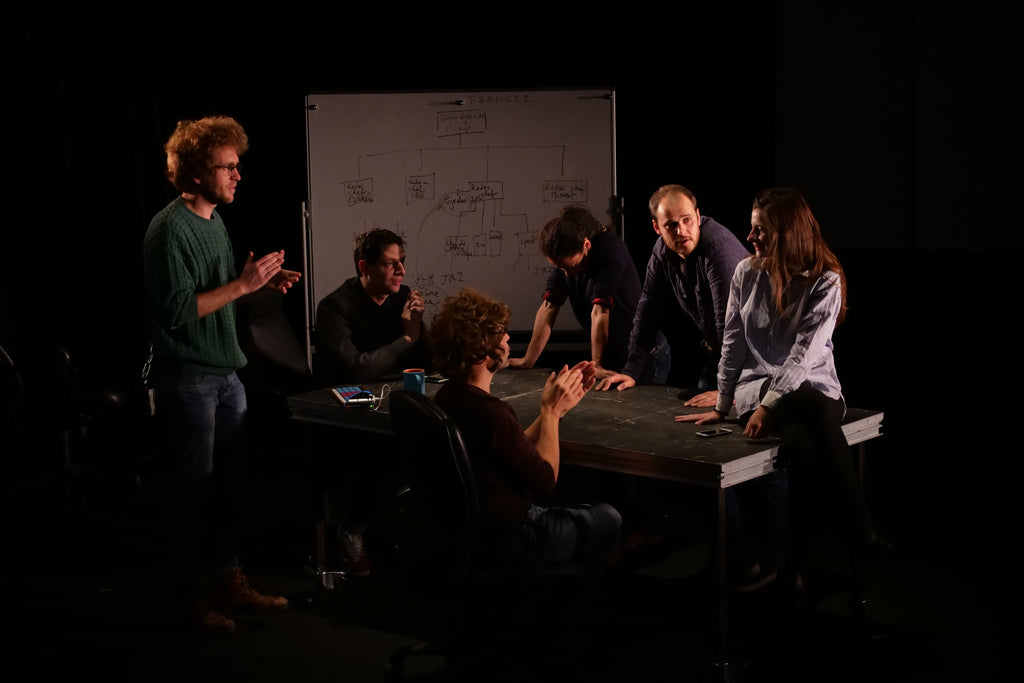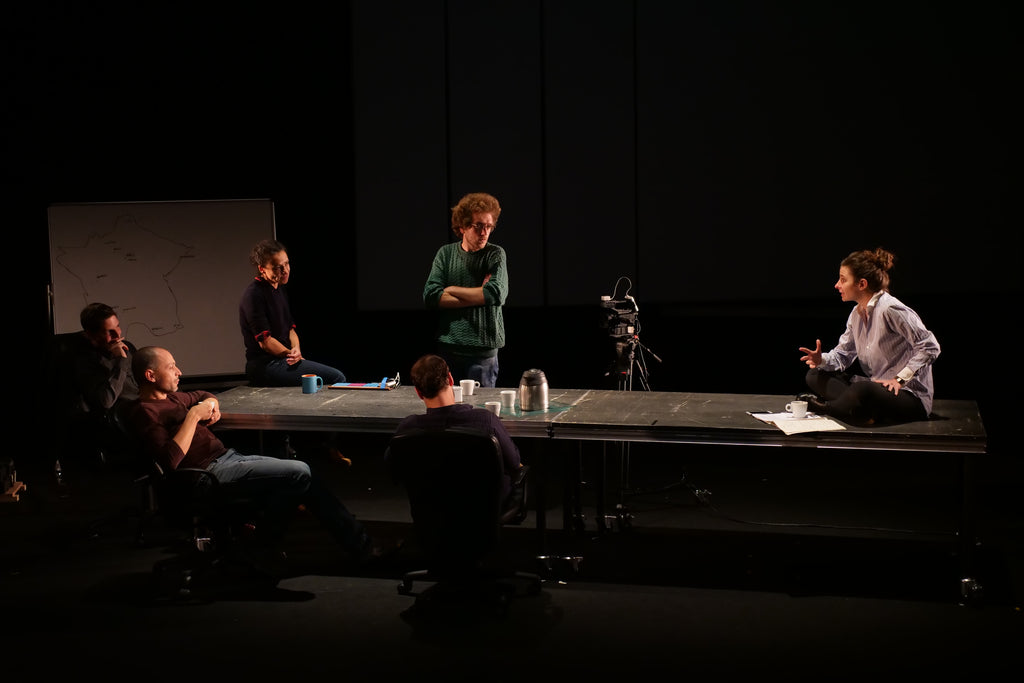The Parisian theater company Légendes Urbaines placed the Joué at the heart of its new play. Controlled onstage by the actors, it is used to manage sound, light and video in real time. Jérémie Gaston-Raoul, the man behind this original use of the Joué, explains how it all works.
“Et c’est un sentiment qu’il faut déjà que nous combattions je crois” is the extensive title of the new play by Légendes Urbaines, a theater company that focuses on addressing urban issues, specifically relating to the French “banlieues”. The play will be presented for the first time from 15 to 22 November at the Théâtre Romain Rolland in Villejuif, near Paris. Jérémie Gaston-Raoul, the astute stage manager who came up with the functioning of this complex installation, tells us about how he uses the Joué.
“The particularity with our work is that we decided hand over the technical management to the actors: stage management is handled right on the stage.”
First of all, can you tell us how you first heard about the Joué?
My job is to develop new stage management techniques for the performing arts, so I’m constantly keeping up with all the types of controllers that I could use in the shows I work on; some are designed just for that, others can be twisted into various uses for the stage. So that’s how I saw the Joué come out, I actually supported the project on Kickstarter. When I received it, we were just starting to work on this new creation, and together with the company we were looking for the right technical solution. We do pure creation with Légendes Urbaines, and we’re always on the lookout for a new means for the actors to write the play. So I put the Joué in their hands and we realized quite quickly that it fit our needs.
Can you explain concretely how the Joué is used on stage, what its place is in the play?
I’ve been working with Légendes Urbaines for nearly ten years now, and this is our third play together. For every new play, according to the issue we’re addressing, we try to find the technical solution that will best serve our intention. The particularity with our work is that we decided from the get-go to hand over the technical management to the actors: stage management is handled right on the stage, with types of controls that are adapted to the specific play. For example, for the first play we did together, which was based on a dramaturgy of displacement, we used sensitive floor tiles on which the actors trod; for the second one, where it was about a dramaturgy of construction, we used cubes equipped with sensors: placing one cube on top of another would trigger a stage management cue [play a sound, change the light, start a video sequence]. With this new play, we’re focusing on the construction of the media myth surrouding the banlieues, so our objective was to find a way to use audio-visual tools on a theater stage. We brought in cameras, a real TV control room, a video mixer, a computer, etc., but we wanted to be able to walk around the stage while continuously being able to control the installation. That’s where the Joué comes into play: in turns, the actors can take control of stage management, from wherever they are. They pass the Joué like a baton in a relay race. When we first started writing the play, we made the Joué easy to carry around by developing a system to make it wireless, we determined the beast way to distribute the use of the different pads among the actors, etc. As it turns out, we use certain modules to control the light, others for video, etc. – the actors change the modules on the Joué during the play.
“On stage, the actors pass the Joué like a relay race baton to trigger light, sound and video effects.”
Why did you choose to use the Joué for this particular usage??
One of its main advantages for us was its modularity. There are many sound, light and video cues during the play, and with the Joué we could dissociate them by using different pads, or decide that each actor would have their own modules: when one of them takes over the Joué, they reconfigure it according to their needs. This opens up infinite usage possibilities, and that was a fundamental aspect for us, because the way they use the device was gradually determined as the play was being written. For example, we have a video mixer with three cameras onstage: with the Joué, from the middle of the stage, the actors can determine which camera feed is projected onto the screen. And then there was also the visual aspect in our choice of the Joué: we didn’t want some random controller that looked like a plastic box with retro-lit buttons. We even designed a wood box attached under the Joué to hide our wireless device, because we see an interest in the object itself, on top of its technical capabilities.
Was it technically difficult to adapt the Joué to such a use?
Well, one big advantage is that sound, video and light cues are usually assignable directly in MIDI. The signals sent to the computer by the Joué, which are converted in order to be wirelessly transmitted, are used by several types of software, particularly QLab that centralizes all the information and triggers all the MIDI effects. Therefore, the communication between the Joué and the software is seamless, and it was easy to assign the actions on the pads to this or that particular effect. As for the lights, I use the Joué’s scaler that I assigned to the MIDI channels on my virtual lighting console. You could do that with any MIDI controller, but the particularity of the Joué is that it’s capable of automatically detecting which pad is placed on it; now I’d like succeed in automatically activating various functionalities accordingly, for example the video player, whenever you place a specific pad on the Joué. All that is quite technical, but the possibilities are endless.
“To us, the great advantage of the Joué is how modular it is. It enables endless possibilities.”
Did the fact it doesn’t look like a typical MIDI controller play a part in your choice of this device rather than another?
When I try out a new device, I always consider its functionalities first, that’s the main priority. But in the case of the Joué, as it’s also an object that’s destined to be visible onstage, the fact that it’s an esthetically pleasing object certainly made a difference. The actors hold it in their hands, they walk around with it, it’s one of the central elements in the management of the entire play, so we needed a device that was reliable, modular and esthetic at the same time, and that’s what we found with the Joué.
Do you see yourself using the Joué for future projects now?
There are still lots of things that can be done, aspects that haven’t been explored yet, that I’ve been talking about with the team at Joué – for example using its surface as a customized remote control for other types of software, independently from MIDI functionalities. With the particular use I make of the Joué, I need to be able to talk with them about advanced technical points, and they are open for discussion. It’s great to have someone you can really talk with and give feedback to.
Interview by Patrick Haour
“Et c’est un sentiment qu’il faut déjà que nous combattions je crois” is performed from 15 to 22 November 2019 at the Théâtre Romain Rolland in Villejuif, then in January 2020 at the Théâtre de Vanves and in March at the Théâtre des Sources in Fontenay-aux-Roses and at Collectif 12 in Mantes-la-Jolie. Additional performances should ensue in 2020.
lien de la billetterie : http://trr.fr/spectacles?et-cest-un-sentiment
Pictures ©J. GASTON-RAOUL



